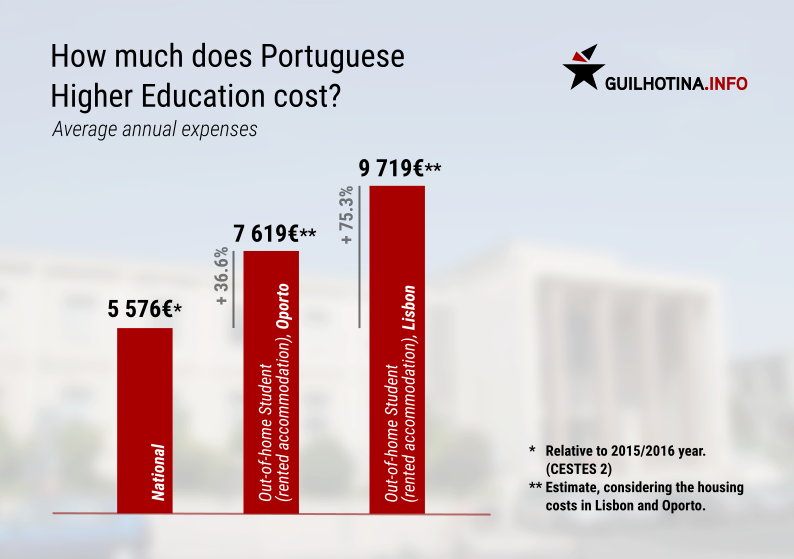Portugal // The adventures of tomorrow’s graduates: expenses with Higher Education~ 5 min

All students in Portugal have to pay tuition fees irrespective of their families’ income.
In my opinion, what I don’t find fair is for it to be free for all, but paid by those who don’t use it.
– Rui Rio, current president of PSD [‘center-right’ Social Democratic Party]
Rui Rio thus outlines the corollary of the “user pays” principle. This is one of the ideological principles which guides the management of Higher Education in Portugal.
The tuition deluge
The increase in tuition fees has reduced the role of the State in the education sector. In 1990, 95% of the budget for Higher Education institutions came from the State budget. The remaining 5% came from its own revenues. In 2008, the first percentage had been reduced to 62,1% and the second had increased to 37,9%. During the school year of 1992 / 1993, the annual tuition fee was 6€. Meanwhile, during the current school year, the maximum tuition is 1 064€ for graduate degrees.
For Master and PhD studies, Higher Education institutions have the freedom to determine their own tuition fees. These fees are often much higher than those of graduate degrees.
A considerable share of the bill for Higher Education is no longer a responsibility of the State and has been taken on by the families whose youngsters wish to study in the university or in a polytechnic institute. Access to Higher Education has therefore become no different than purchasing any other commodity, as if the right to education was merely a transaction between private parties.
For the school year of 2015 / 2016, the average amount required to attend a public Higher Education course in Portugal was 5 576€ per year. This amount includes direct education costs, such as tuition fees and other administrative fees and books. But is also includes current expenses like housing, food, transportation and health care.
The direct education costs required to attend classes and access evaluations was 1 283€ per year. These costs are mostly defined and regulated by the State. The minimum and maximum costs for graduate degrees in public institutions are regulated on a national basis. Therefore, the geographic variation of these costs is not particularly significant.
“Big opportunity: room for rent, 400 euros/month”
The student accommodations provided by universities have a reduced price. Students who receive a scholarship are given either a shared room free of charge or pay a very low rent. In the case of students who do not receive a scholarship, the university’s social services charge higher prices, between 100€ and 200€ on average.
However, in 2016 / 2017, only 13% of displaced students were actually living in a university residence, even though they represent 42% of all national students. The main cause: an undersupply of public university accommodation. As a consequence, for many displaced students, renting a private room appears to be the only solution. Most student expenses are current expenses and housing costs are the most expressive of all. In 2015 / 2016, the average amount of current expenses was 4 293€.
Housing costs, which are mainly regulated by the real estate market, vary tremendously according to geographic location. On the one hand, a displaced student spends on average 14% more than a local student; on the other hand, the housing costs in big cities like Lisbon and Oporto are much higher than in country towns like Covilhã, for example.
According to the data recently released by Uniplacles, the average monthly cost of renting a room in 2018 was 377€ in Lisbon and 287€ in Oporto. If we take these housing costs into consideration and assume that all other expenses are the same as for a displaced student in coastal areas during the year 2015 / 2016, we can make a reasonable estimate of the current annual expenses of displaced students in these cities.

We conclude that 8 843€ are needed annually to study in Lisbon and 7 763€ to study in Oporto. This means that it costs fifteen times the Portuguese minimum wage to study in Lisbon and thirteen times to study in Oporto.
“Do you want to be able to make a living and study at the same time? Find out more below”
These costs are obviously unaffordable for families with lower incomes. For them there will always be other alternatives: renting a room in a smaller town close to the location of the Higher Education institution. Renouncing an active social life. Renouncing buying the recommended bibliography. Eating less healthy food. Becoming a working student.
Obviously, there will also the possibility that these students (and their families) cannot afford these expenses at all and will instead abandon university. It just so happens that the biggest motivation for abandoning Higher Education is economic reasons.
A thorn in the side
Nowadays, accommodation and tuition fees are the two strongest obstacles to attendance of public Higher Education. Both are the result of the State’s disengagement from the education sector.
On the one hand, displaced students, in the absence of university accommodation, fall victim to the dynamics of the real estate market, which is solely profit-oriented. The housing crisis in Lisbon and Oporto has made these cities prohibitive places to live in. On the other hand, with the increase in tuition fees, a huge bill has emerged which became unaffordable for families, particularly for those of lower incomes, who naturally tend to be working class.
The (financial) sinking ship and scholarships
Coming back to the arguments of neoliberal technocrats:
Social support in education should not involve the elimination of tuition fees, but the granting of scholarships.
– Rui Rio, current president of PSD [‘center-right’ Social Democratic Party]
What Rui Rio is telling us is that those who can afford the costs should have free access. Meanwhile, the poor must apply for scholarships. Only after a slow and arduous evaluation process will they know if they are worthy of attending Higher Education.
Finally, the lucky ones who have been given permission to study will receive scholarships which are inadequate to meet reality’s demands. The problem of inequality over access to Higher Education is thus reduced but not at all solved.
End of part one.




